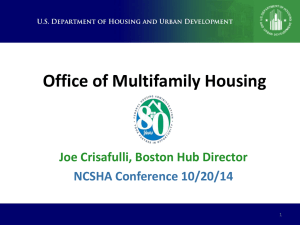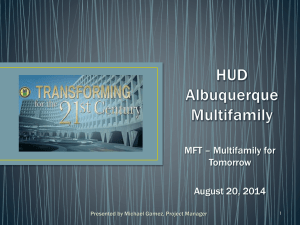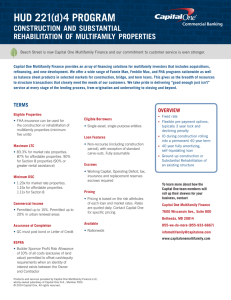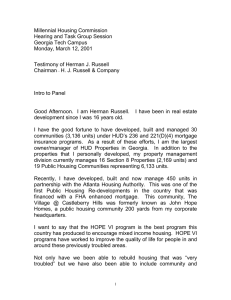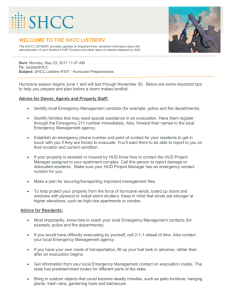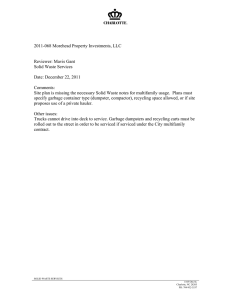explanatory matrix
advertisement
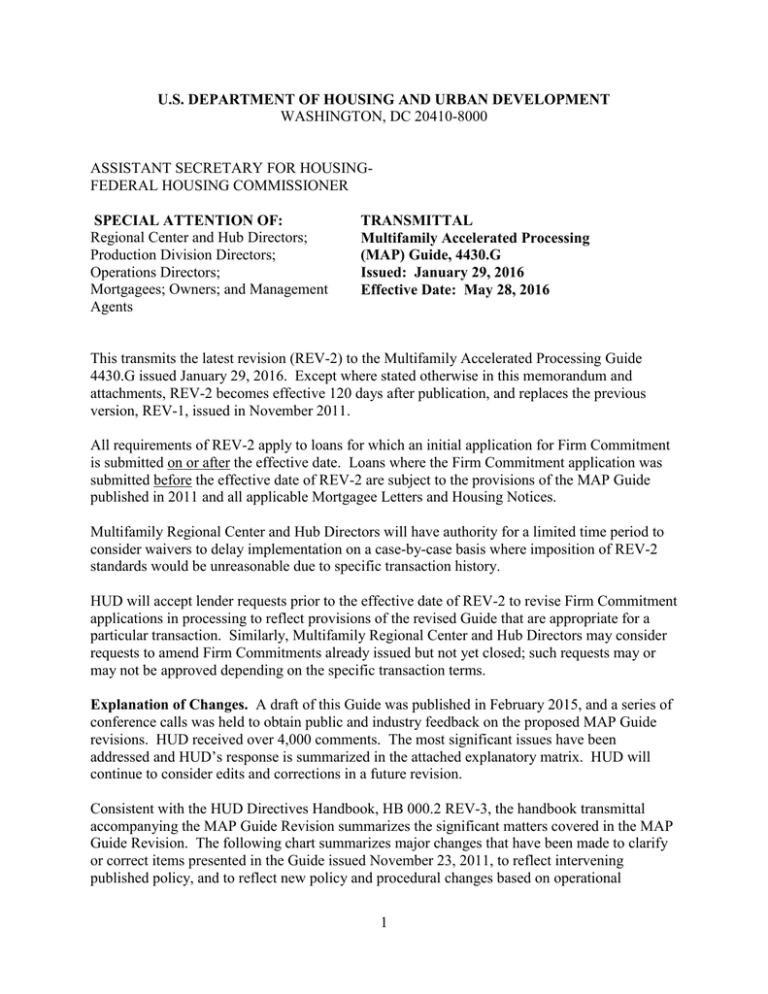
U.S. DEPARTMENT OF HOUSING AND URBAN DEVELOPMENT WASHINGTON, DC 20410-8000 ASSISTANT SECRETARY FOR HOUSINGFEDERAL HOUSING COMMISSIONER SPECIAL ATTENTION OF: Regional Center and Hub Directors; Production Division Directors; Operations Directors; Mortgagees; Owners; and Management Agents TRANSMITTAL Multifamily Accelerated Processing (MAP) Guide, 4430.G Issued: January 29, 2016 Effective Date: May 28, 2016 This transmits the latest revision (REV-2) to the Multifamily Accelerated Processing Guide 4430.G issued January 29, 2016. Except where stated otherwise in this memorandum and attachments, REV-2 becomes effective 120 days after publication, and replaces the previous version, REV-1, issued in November 2011. All requirements of REV-2 apply to loans for which an initial application for Firm Commitment is submitted on or after the effective date. Loans where the Firm Commitment application was submitted before the effective date of REV-2 are subject to the provisions of the MAP Guide published in 2011 and all applicable Mortgagee Letters and Housing Notices. Multifamily Regional Center and Hub Directors will have authority for a limited time period to consider waivers to delay implementation on a case-by-case basis where imposition of REV-2 standards would be unreasonable due to specific transaction history. HUD will accept lender requests prior to the effective date of REV-2 to revise Firm Commitment applications in processing to reflect provisions of the revised Guide that are appropriate for a particular transaction. Similarly, Multifamily Regional Center and Hub Directors may consider requests to amend Firm Commitments already issued but not yet closed; such requests may or may not be approved depending on the specific transaction terms. Explanation of Changes. A draft of this Guide was published in February 2015, and a series of conference calls was held to obtain public and industry feedback on the proposed MAP Guide revisions. HUD received over 4,000 comments. The most significant issues have been addressed and HUD’s response is summarized in the attached explanatory matrix. HUD will continue to consider edits and corrections in a future revision. Consistent with the HUD Directives Handbook, HB 000.2 REV-3, the handbook transmittal accompanying the MAP Guide Revision summarizes the significant matters covered in the MAP Guide Revision. The following chart summarizes major changes that have been made to clarify or correct items presented in the Guide issued November 23, 2011, to reflect intervening published policy, and to reflect new policy and procedural changes based on operational 1 experience, the Multifamily For Tomorrow (MFT) transformation currently in process, and feedback from the public. Major Changes Editing Prior Guidance Chapters 5 & 6 The entire Guide has been edited for grammatical errors, reformatted for consistency, and repaginated to accommodate the changes. Prior HUD Mortgagee Letters that have been incorporated and/or superseded by this MAP Guide Revision include: ML 11-32, Underwriting Policies and Procedures for Commercial Space and Income in HUD-Insured Multifamily Projects ML 11-40, Large Loan Risk Mitigation Policies ML 12-08, Policy Regarding Interest Rate Swap Termination Fees Associated with Debt to be Refinanced in Connection with Healthcare and Multifamily Mortgage Insurance Applications ML 12-16, Multifamily Housing and Healthcare Facilities Implementation of Pay.gov for Annual Mortgage Insurance Premiums ML 12-25, Revised Requirements for Project Capital Needs Assessments, Estimated Reserves for Replacements and Remedies for Accessibility Deficiencies ML 13-07, HUD Office of Multifamily Development Radon Policy ML 13-09, Concentration of Principal Risk; Principals with Insured Assets Greater than $250 Million ML 14-04, Revisions to Large Loan Risk Mitigation Policies ML 14-05, Standardized Multifamily FHA Mortgage Insurance Applications ML 14-18, Revisions to Large Loan Risk Mitigation Policies ML 15-13, Implementation of Pay.gov for Multifamily Program Fees ML 15-16, Underwriter Approval Delegation Chapters 5 and 6 (and related appendices) of the 2011 MAP Guide were consolidated and substantially rewritten introducing new concepts and modifying prior guidance as follows: The maximum cost of repairs threshold distinguishing substantial rehabilitation from refinancing was increased. Classifications of work are defined as a means of providing improved gradation of eligible construction activities by program and better methods for managing design and construction activities. Revised methods for evaluating physical conditions and documenting immediate repair needs of existing properties as well as future capital needs for all properties are incorporated in tandem with measures to implement an automated process for this work known as the CNA e Tool. Based on experience and stakeholder comments more flexible financial modeling methods and revised reserve for replacement funding parameters are adopted. 2 Chapters 14&16 Tax Credits Chapter 14, entirely devoted to tax credits, includes many new elements not previously addressed in the MAP Guide. It also incorporates previously informal guidance, including administrative memoranda published since 2011 that addressed changes to the equity pay-in schedule, new guidance on bridge loans, Identity of Interest (“IOI”) transaction allowances, structuring of subordinate debt and developer fee limits, relaxed limits on total debt allowed under the 223(f) program for Pilot projects, provided more information on IOI transfers, completion assurance requirements, timing of repair escrow funding, tax credit allocation timing and evidence requirements, tax abatements, 2530 requirements and various other due diligence requirements for passive partners and nonprofit boards, and timing of building permits. Other key areas of change include limits and structuring of secondary debt, single underwriter processing, use of HAP Contracts, Architecture and Engineering requirements, Mortgage Credit Review requirements, a final payin schedule along with Equity Bridge Loan requirements and restrictions, syndicator fees and underwriting vacancy rates, and use of tax exempt bonds with 4% Tax Credits and FHA financing. Chapter 16’s previous version addressed lease structures in all kinds of projects, but in this version, it addresses only master lease structures used in projects with New Markets Tax Credits and Historic Tax Credits. It addresses all of the relevant FHA programmatic rules, processing requirements, cost certification and final endorsement procedures. Chapter 18 A new Chapter 18 was created to provide specific guidance regarding Section 223(a)(7) program application processing. It will replace applicable portions of the following directives: Handbook 4567.1, Refinancing of Insured Multifamily Projects Pursuant to Section 223(a(7) Housing Notice 93-89, Expedited Section 223(a)(7) Processing Instructions Mortgagee Letter 94-17, Refinancing of Insured Mortgages Pursuant to Section 223(a)(7) of the National Housing Act – Questions and Answers Mortgagee Letter 2006-03, Refinancing for FHA Insured Multifamily Project Three Year Rule HUD will no longer provide waivers. The six month standard proposed for affordable properties has not been included in the Revised Guide. Substantial The maximum per unit cost of rehabilitation allowed under the Section 223(f) Rehabilitation program has been raised from $6,500 times the Area High Cost Percentage to Threshold $15,000, indexed for inflation going forward, times the Area High Cost Percentage. CNA e Tool The Revised MAP Guide is written to accommodate the mandatory use of the CNA e Tool and requires the preparation of Capital Needs Assessments for all properties (including new construction and substantial rehabilitation). However, the CNA e Tool is not presently ready for use. It is expected that the CNA e Tool will be available to HUD users during 2016. Accordingly, 3 Capital Needs Assessments will not be accepted through the CNA e Tool until HUD publishes further instructions by Housing Notice and/or Mortgagee Letter. During the interim, requirements of this MAP Guide that cannot be executed absent the CNA e Tool are suspended. Such suspended requirements include the following: The general requirement that Capital Needs Assessments be prepared in the CNA e Tool; Automated lender submission of CNAs and HUD staff automated review of CNAs, together with the automated “flag” system for identifying and resolving errors, omissions and issues; Utility consumption benchmarking, including the submission and use of EPA Portfolio Manager reports, and ASHRAE Level II Energy Audits. Notwithstanding the suspension of utility metrics requirements, lenders may underwrite up to 75% of utility cost savings for existing buildings provided that such savings are calculated by a qualified energy professional in an ASHRAE Level II Energy Audit. Numerous requirements embedded in the CNA e Tool and so characterized in the MAP Guide can be met by other means such as capital needs assessments, reserve for replacement funding schedules, and similar documentation and worksheets prepared by due diligence providers and lenders in the same way as they have been prepared in the past. These requirements are not suspended, even when the MAP Guide indicates that they are to be met or prepared in the CNA e Tool. Examples of such requirements include: The requirement that an analysis of future capital replacement needs and a reserve for replacement funding schedule be prepared for all applications, including new construction and substantial rehabilitation; Use of the CNA e Tool Standard Table of Estimate Useful Life of components which is available as a spreadsheet; Submission of Seismic threshold values generated from the National Geographic Survey website; Use of initial and future estimated percentage annual rates of change in cost inflation of capital needs, interest earnings on reserve for replacement escrow account balances and annual replacement reserve deposits (financial factors). Use of 20 years as the estimate period for CNAs Use of the 2 step, 10 year-20 year revised method for estimating reserve for replacement funding and mitigation of negative balances appearing in years 11 to 20 when the amount of any such negative balance exceeds 50% of aggregate amortization of loan principal for that relevant year (See Appendix 5G, Section VII Subsection B, paragraph 6 and Subsection C paragraph 3.d) For existing properties, inspection of a minimum sample of 25% of units (Appendix 5G, Section V, subsection B) Determination of whether property is federally assisted, yes or no; 4 Processing Changes Workload Distribution Updated terminology from MFT Elderly or AgeRestricted Housing Mandatory Meals Protected Classes Defeasance Commercial Space Use of occupancy and building permit data by structure to determine applicability of the design and construction requirements of the Fair Housing Act whenever the year built is reported as 1990, 1991 or 1992. Risk-based Processing/Single UW Model. Applications will be processed by HUD staff with appropriate levels of technical expertise depending on the complexity and/or risk level of the application. The new Workload Sharing process has been institutionalized. Applications will be distributed among the 5 “future state” Regions around the country. Work is moved from Regions with greater workload to those of greater capacity. Location names and job titles such as (but not limited to) Hub, Program Center, Hub Director, Program Center Director, Multifamily Housing Representative, Housing Project Manager, and Mortgage Credit Analyst are being phased out, and replaced with titles such as Regional Center, Satellite Office, Underwriter, Sr. Underwriter, Underwriter Analyst, and Closing Coordinator. The Revised Guide reflects these changes. Chapter 3 provides technical guidance regarding elderly and age-restricted housing; for new construction and/or market rate properties, FHA will maintain the long-standing policy that all units of age-restricted projects have elderly head of households (62 years or older) and cannot prohibit occupancy by non-elderly family members including children. HUD will only provide waivers to use the 55 years and older exemption for the refinance or acquisition of affordable properties which were in compliance with the regulatory exemption criteria for at least three years prior to the Firm Commitment. Mandatory meal programs will be considered under the limited circumstance of refinanced Section 202 properties, or currently FHA insured properties with Project-Based rental assistance which have continuously provided such services since before September 30, 1991. New language has been added throughout the Guide to prohibit discrimination based on age or LGBT status. The 2011 MAP Guide prohibited the recognition of defeasance and/or costs associated with the prepayment of derivative instruments in the cost basis calculation in a proposed refinancing transaction. The revised Guide allows recognition of such costs up to 10% of the proposed FHA insured loan. The revised MAP Guide incorporates underwriting guidance from Mortgagee Letter 2011-32, and makes further revisions to simplify program execution. The revisions provide more flexibility to allow greater commercial space and income, in order to better facilitate urban development and mixed use projects. The MAP Guide limitations strike the appropriate balance between facilitating mixed use financing and acceptable risk to the FHA insurance fund. HUD will conduct a series of conference calls over the next 3 months to discuss changes and to answer questions. Additionally, training will be scheduled to cover specific topics such as the 5 CNA eTool, changes in Reserves requirements, environmental analysis, and MFT. Questions or comments about this Transmittal may be sent to the following e-mail address: mapguide2016@hud.gov . Filing Instructions: Remove: MAP Guide, REV-1 dated 11/23/2011 Insert: MAP Guide 2016 REV-2 dated 1/29/2016 __________________________________ Ed Golding Principal Deputy Assistant Secretary HUD Office of Housing & FHA 6
